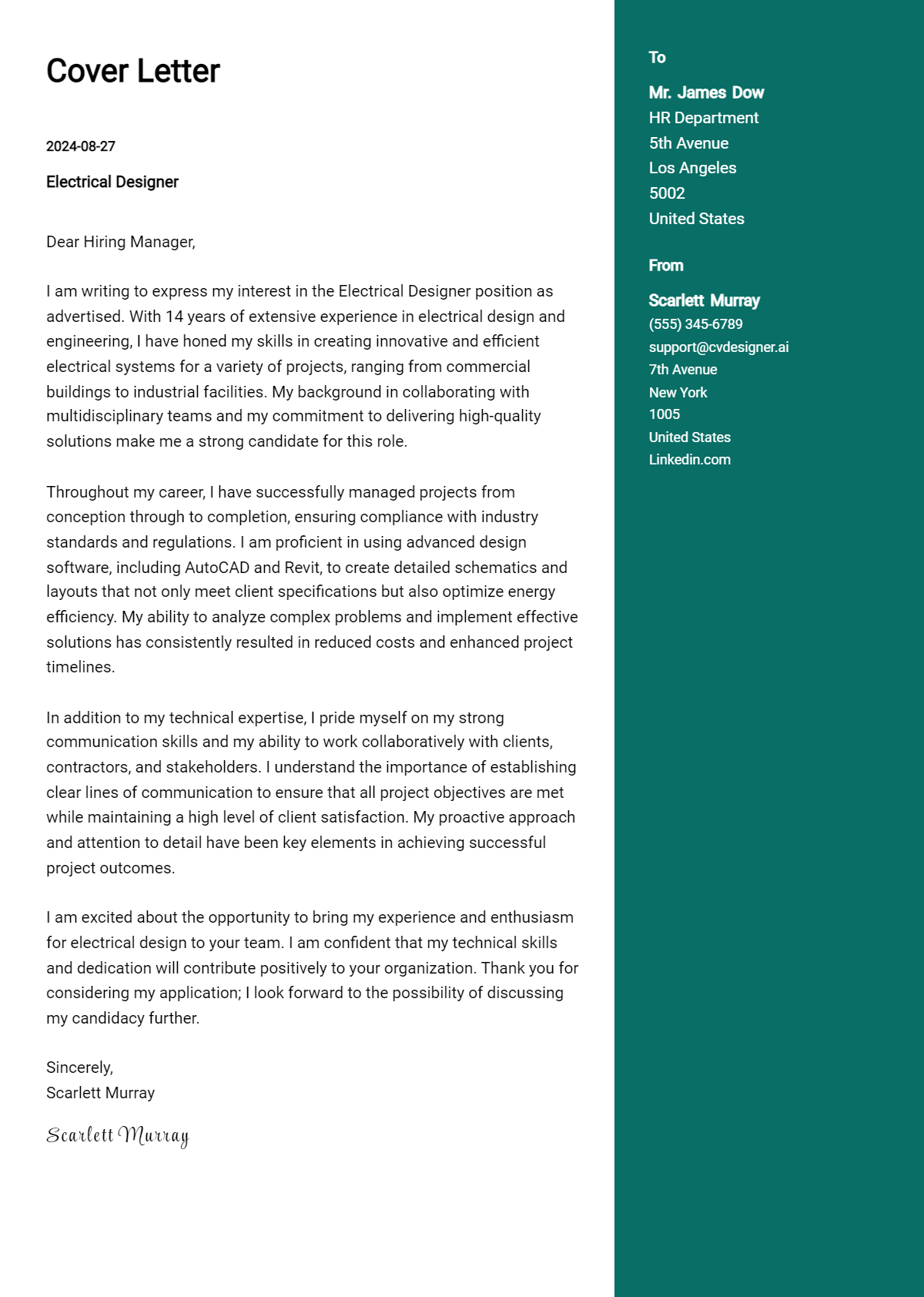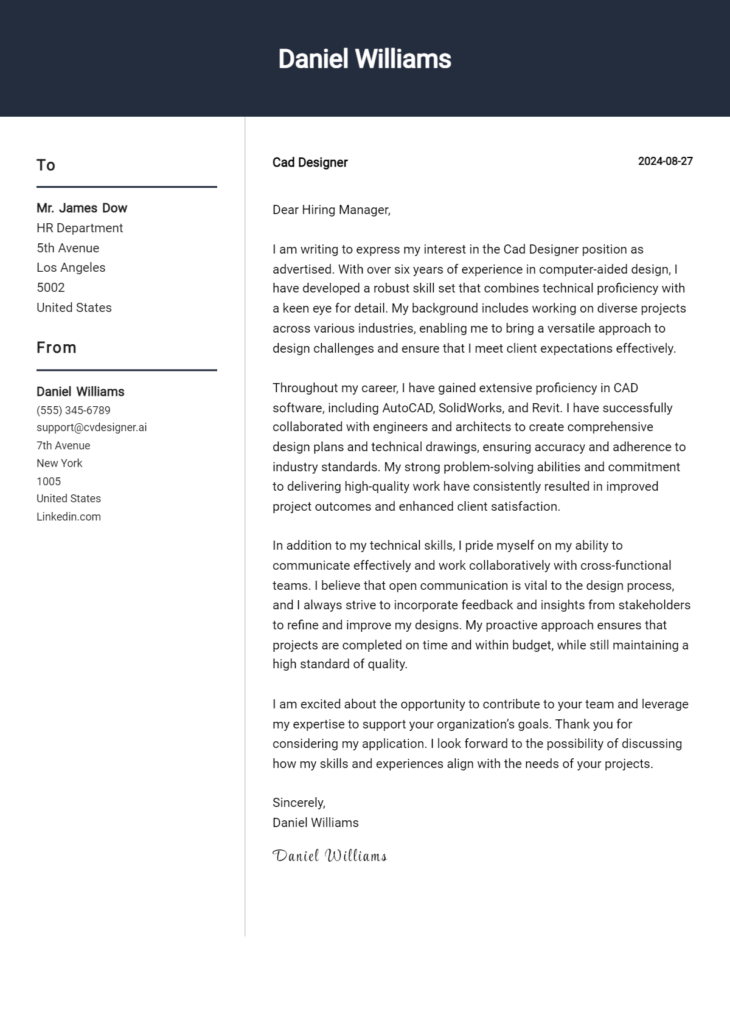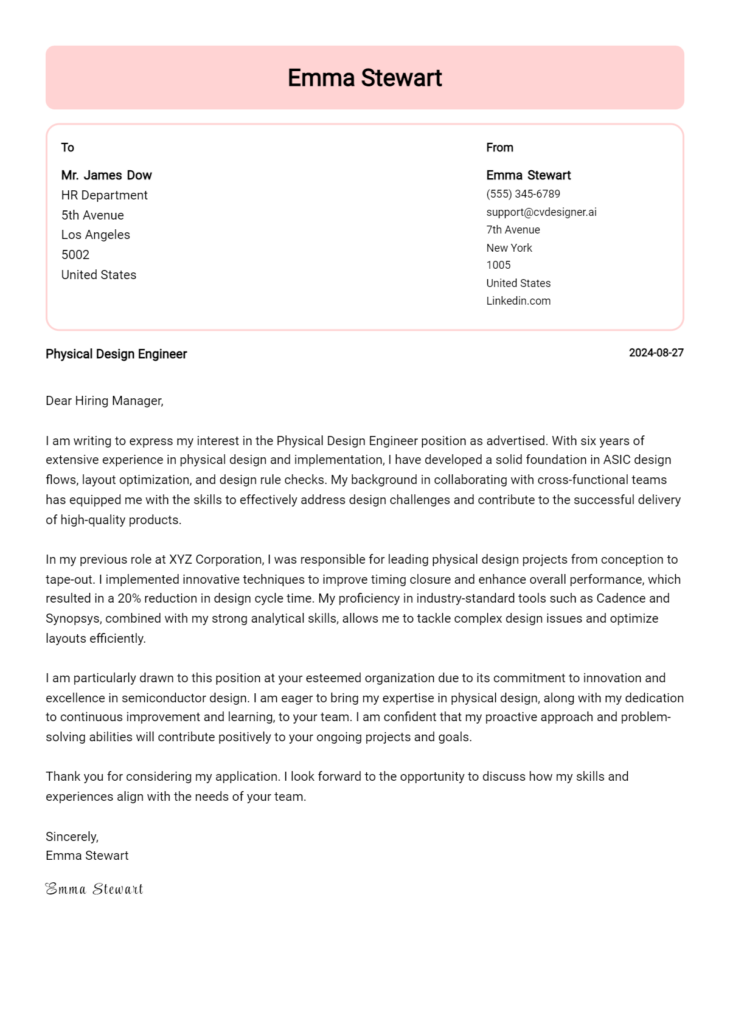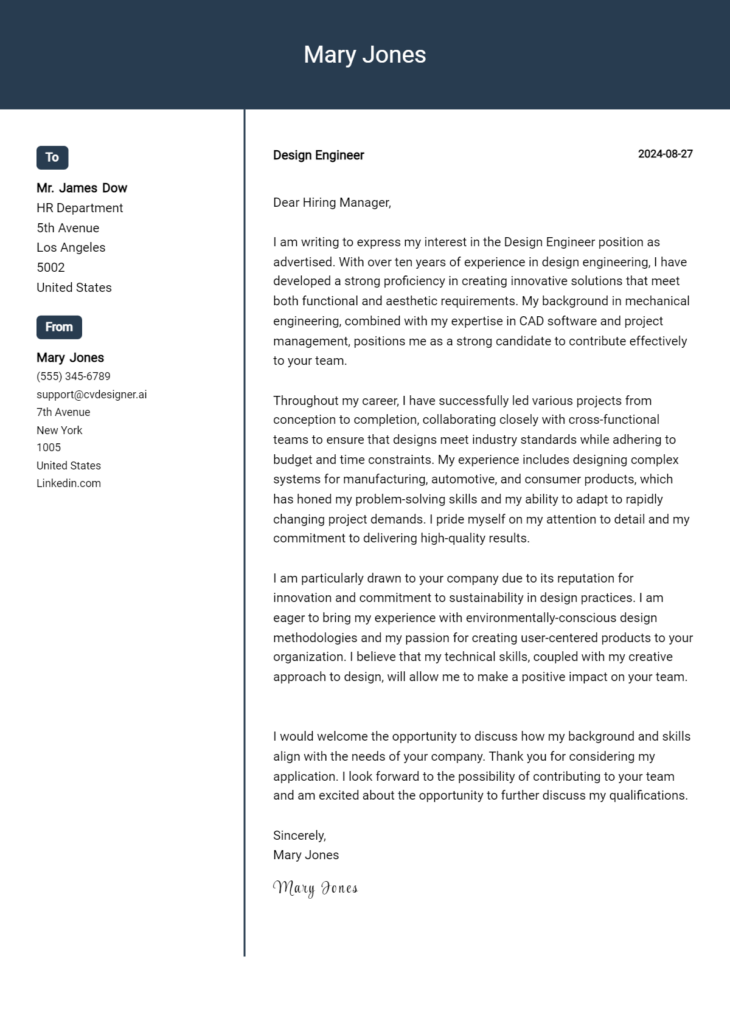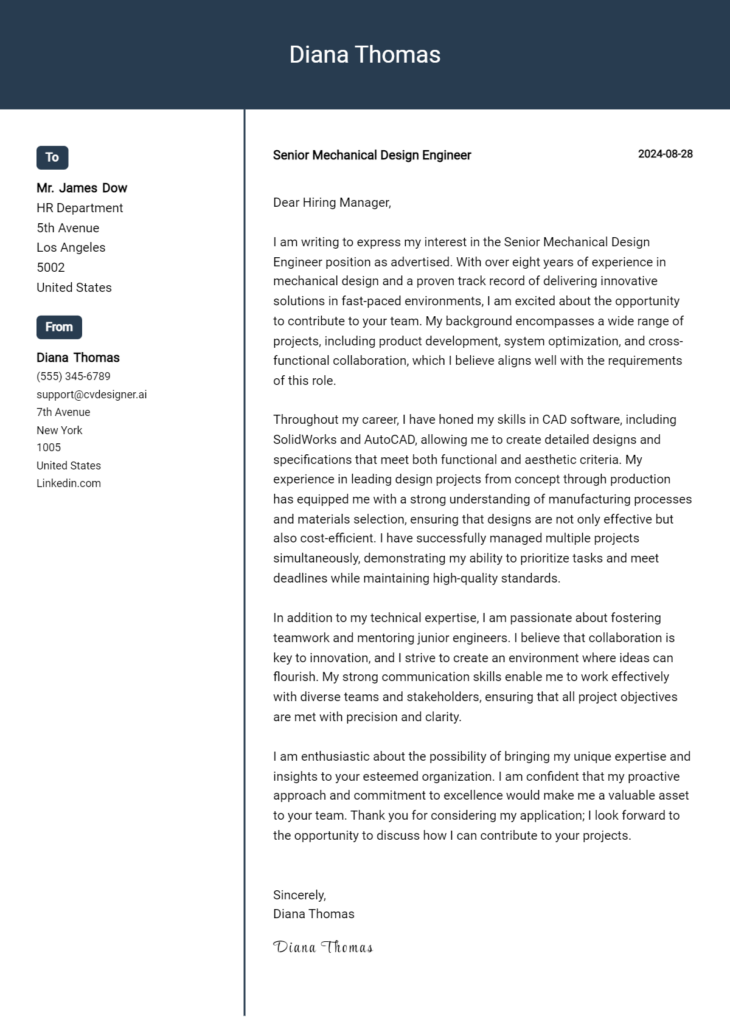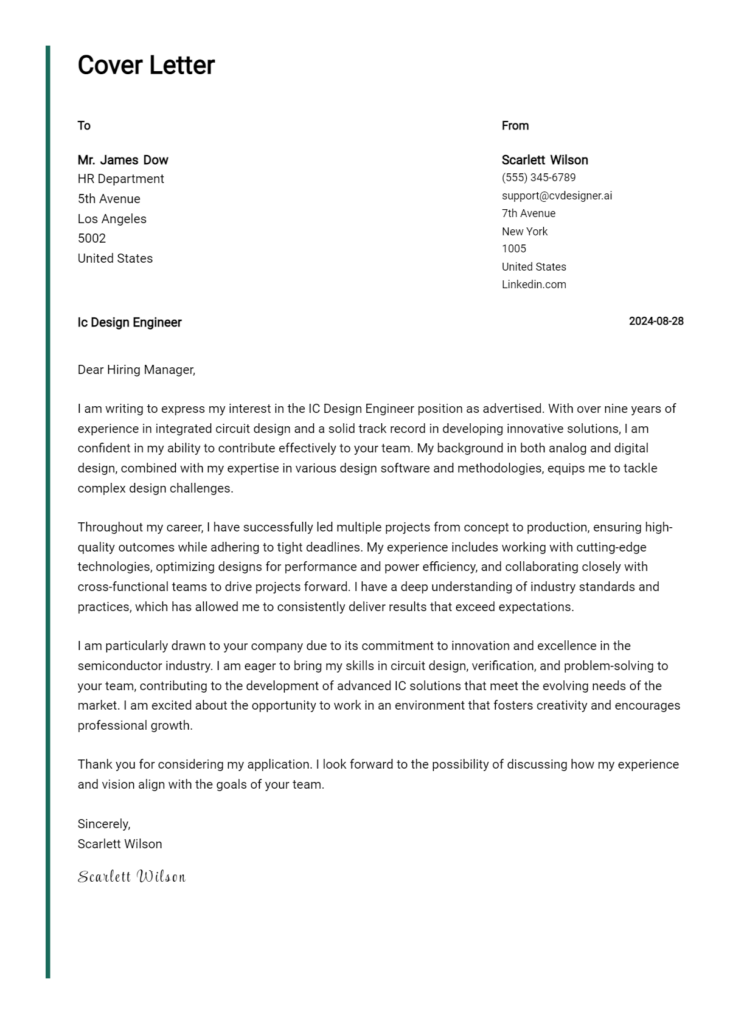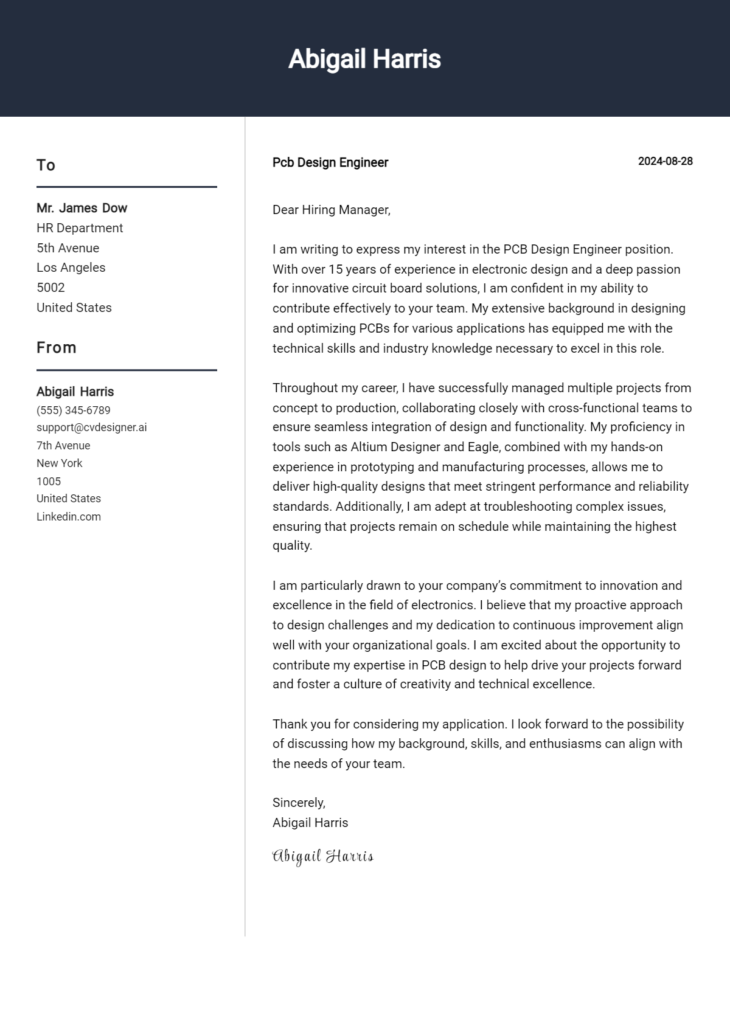Most Popular Electrical Designer Cover Letter Examples
Explore additional Electrical Designer cover letter samples and guides and see what works for your level of experience or role.
Crafting an impactful cover letter is crucial for aspiring Electrical Designers looking to stand out in a competitive job market. This guide will walk you through the essential elements of writing a compelling cover letter that highlights your skills and experiences, ensuring you make a lasting impression on potential employers. By the end of this article, you will have a better understanding of what makes a great Electrical Designer cover letter and how to effectively communicate your qualifications. Here’s what we will cover:
- What does an Electrical Designer Cover Letter accomplish?: Understand the purpose and importance of a well-crafted cover letter in your job application.
- Key Components of an Electrical Designer Cover Letter: Learn about the essential elements that should be included to showcase your expertise.
- Format an Electrical Designer Cover Letter: Discover the best practices for formatting your cover letter to ensure it is professional and easy to read.
- Three different level cover letter examples: Review tailored cover letter samples for entry-level, mid-level, and senior Electrical Designer positions.
- Common Mistakes to Avoid in an Electrical Designer Cover Letter: Identify frequent pitfalls in cover letter writing and how to steer clear of them.
- Key Takeaways: Recap the most important points to remember when crafting your cover letter.
Dive in to unlock the secrets to creating a standout cover letter that will help you land your dream job as an Electrical Designer!
What does a Electrical Designer Cover Letter accomplish?
A cover letter for an Electrical Designer serves as a crucial introduction to potential employers, providing a personalized narrative that highlights the candidate's relevant skills, experiences, and enthusiasm for the role. It allows the applicant to elaborate on their technical expertise in electrical systems, design software, and project management, while also showcasing their problem-solving abilities and creativity. By effectively communicating how their background aligns with the job requirements, the cover letter can set the candidate apart from others. For those looking to craft an impactful letter, resources like our cover letter guide and cover letter builder can provide valuable insights and tools.
Key Components of a Electrical Designer Cover Letter
- Introduction and Purpose: Start your cover letter with a strong introduction that specifies the position you are applying for and includes a brief statement about your enthusiasm for the role. This section sets the tone and captures the employer's attention right away.
- Relevant Experience and Skills: Highlight your key qualifications, such as your experience with electrical design software, knowledge of electrical codes, and any relevant projects you've worked on. Tailor this section to showcase how your skills align with the job requirements specified in the job description.
- Achievements and Contributions: Provide specific examples of your past achievements that demonstrate your ability to contribute effectively to the team. This could include successful project completions, cost-saving designs, or innovations you introduced. Quantifying your accomplishments can make a significant impact.
- Closing Statement and Call to Action: Conclude your cover letter with a strong closing statement expressing your interest in the role and a desire for an interview. Reinforce your enthusiasm and provide your contact information, encouraging the employer to reach out. For additional insights, consider reviewing cover letter examples and understanding the proper cover letter format.
How to Format a Electrical Designer Cover Letter
As an Electrical Designer, your cover letter should reflect your technical expertise, creativity, and problem-solving skills. It’s essential to convey your understanding of electrical systems, design software, and industry standards. Here are some key points to include in your cover letter:
- Begin with a strong opening statement that captures your enthusiasm for the role and the company.
- Highlight your relevant educational background, such as a degree in Electrical Engineering or a related field.
- Mention your experience with electrical design software, such as AutoCAD, Revit, or ETAP, and any specific projects where you utilized these tools.
- Discuss your familiarity with industry standards and codes, such as NEC or IEC, demonstrating your ability to create compliant designs.
- Provide examples of projects where you successfully collaborated with architects, engineers, and other stakeholders to achieve design goals.
- Emphasize your problem-solving skills by sharing instances where you overcame design challenges or improved project efficiency.
- Mention any certifications or licenses you hold, such as EIT (Engineer in Training) or PE (Professional Engineer), to establish your credibility.
- Include your ability to work on multiple projects simultaneously while meeting deadlines and maintaining high-quality standards.
- Highlight your communication skills, particularly in conveying complex electrical concepts to non-technical team members or clients.
- Conclude with a strong closing statement that reiterates your interest in the position and your eagerness to contribute to the team.
Electrical Designer Entry-Level Cover Letter Example #1
I am writing to express my interest in the Electrical Designer position at [Company Name] as advertised on [Job Board/Company Website]. As a recent graduate with a Bachelor’s degree in Electrical Engineering from [Your University], I am eager to apply my academic knowledge and hands-on experience to contribute to your team. My coursework, combined with my internships, has equipped me with a solid foundation in electrical systems design and a passion for innovative solutions.
During my internship at [Previous Company Name], I had the opportunity to work closely with senior electrical engineers on various projects, including the design and layout of electrical systems for commercial buildings. I assisted in creating detailed schematics using AutoCAD, which enhanced my technical skills and attention to detail. This experience taught me the importance of collaboration and effective communication within a team, as we often worked together to troubleshoot issues and implement design improvements.
Additionally, my academic projects have provided me with practical experience in circuit design and analysis. For instance, I led a team project where we designed a sustainable energy system for a local community building, integrating solar panels and energy-efficient lighting. This project not only honed my technical skills but also strengthened my ability to manage deadlines and coordinate with team members to achieve our goals. I am confident that my proactive approach and commitment to quality work will make me a valuable asset to your team.
I am excited about the opportunity to bring my skills and enthusiasm to [Company Name]. I am particularly drawn to your commitment to innovation and sustainability in electrical design, and I am eager to contribute to your projects while continuing to learn and grow in my career. Thank you for considering my application. I look forward to the possibility of discussing how I can contribute to your team and help achieve your company’s goals.
Electrical Designer Mid-Level Cover Letter Example #2
I am writing to express my interest in the Electrical Designer position at [Company Name] as advertised on [Job Posting Source]. With over five years of experience in electrical design and a strong foundation in both residential and commercial projects, I am excited about the opportunity to contribute to your team and help innovate solutions that enhance efficiency and functionality.
In my previous role at [Previous Company Name], I successfully led the design and implementation of several high-profile projects, including a state-of-the-art commercial office building and a multi-family residential complex. My responsibilities included developing detailed electrical plans, conducting load calculations, and ensuring compliance with local and national electrical codes. I worked closely with architects and construction teams to integrate electrical systems seamlessly into the overall design, which greatly improved project timelines and reduced costs. The experience honed my ability to manage complex projects from concept through completion, while maintaining a high level of quality and attention to detail.
Additionally, I possess strong skills in AutoCAD and Revit, which I utilized to create precise and efficient designs. I have also been involved in the coordination of multidisciplinary teams, ensuring that all electrical systems align with mechanical and structural designs. My proficiency in these tools, combined with my commitment to staying current with industry trends and advancements, allows me to deliver innovative solutions that meet the evolving needs of clients.
I am particularly drawn to [Company Name] because of your commitment to sustainability and cutting-edge technologies. I admire your recent projects, such as [specific project or initiative], and I am eager to contribute my skills in designing energy-efficient electrical systems that align with your company's vision. I am confident that my background and passion for electrical design will make me a valuable asset to your team.
Thank you for considering my application. I look forward to the opportunity to discuss how my experience and vision align with the goals of [Company Name]. I am excited about the possibility of contributing to your esteemed projects and helping drive innovation in electrical design.
Electrical Designer Experienced Cover Letter Example #3
I am excited to submit my application for the Electrical Designer position at [Company Name]. With over [number] years of extensive experience in electrical design and a track record of successfully delivering innovative solutions in a variety of sectors, I am confident in my ability to contribute effectively to your team. My background in designing complex electrical systems, combined with my proficiency in industry-leading software tools, positions me as a strong candidate for this role.
Throughout my career, I have been involved in a diverse range of projects, from commercial buildings to industrial facilities. At [Previous Company Name], I played a pivotal role in the design and implementation of a state-of-the-art electrical system for a major manufacturing plant. My responsibilities included conducting load calculations, creating detailed schematics, and ensuring compliance with industry standards and regulations. I collaborated closely with architects and engineers to integrate the electrical designs seamlessly within the overall project framework, which resulted in a 15% reduction in energy consumption through the use of innovative lighting solutions.
In addition to my technical skills, I pride myself on my ability to manage multiple projects simultaneously while maintaining a keen eye for detail. I have successfully led teams in developing and executing project plans, ensuring that all deadlines were met and quality standards upheld. My experience with budget management and vendor negotiations has also allowed me to deliver projects on time and within budget, enhancing overall client satisfaction.
Moreover, my commitment to staying current with advancements in electrical design practices has enabled me to implement cutting-edge technologies in my work. I am well-versed in software programs such as AutoCAD, Revit, and ETAP, and I actively seek out professional development opportunities to further hone my skills. My proactive approach has not only improved my designs but has also fostered a culture of innovation within my teams.
I am eager to bring my experience and dedication to [Company Name]. I am confident that my background and skills align well with the needs of your organization, and I look forward to the opportunity to contribute to your projects. Thank you for considering my application. I hope to discuss how my expertise can be an asset to your team in further detail.
Cover Letter Tips for Electrical Designer
When crafting a cover letter for an Electrical Designer position, it's essential to highlight your technical skills, design experience, and ability to collaborate on complex projects. Tailor your letter to the specific job description, showcasing relevant projects and achievements that demonstrate your expertise in electrical design, compliance with industry standards, and innovative problem-solving abilities. Use clear and concise language, and ensure your enthusiasm for the role and the company shines through. Remember to convey not just what you can do, but how your contributions could specifically benefit the organization.
Cover Letter Tips for Electrical Designer:
- Tailor Each Letter: Customize your cover letter for each job application by addressing specific requirements mentioned in the job description.
- Highlight Relevant Experience: Focus on your most relevant projects, including specific technologies, software, and methodologies you've used in your electrical design work.
- Showcase Technical Skills: Mention any specialized skills or certifications (e.g., AutoCAD, Revit, or electrical codes) that are particularly relevant to the role.
- Quantify Achievements: Use numbers or metrics to demonstrate the impact of your work, such as cost savings, efficiency improvements, or successful project completions.
- Emphasize Collaboration: Discuss your experience working with cross-functional teams, including engineers, architects, and project managers, to highlight your teamwork abilities.
- Express Passion for the Field: Convey your enthusiasm for electrical design and innovation, showing your commitment to staying updated on industry trends and advancements.
- Keep it Professional: Use a formal tone and structure, ensuring there are no spelling or grammatical errors, as attention to detail is crucial in engineering roles.
- Call to Action: End your cover letter with a strong closing statement that expresses your desire for an interview and your eagerness to discuss how you can contribute to the company.
How to Start a Electrical Designer Cover Letter
As an aspiring Electrical Designer, crafting an engaging cover letter introduction is crucial to make a strong first impression. Here are some examples that effectively capture attention:
I am excited to apply for the Electrical Designer position at [Company Name], as my extensive experience in designing electrical systems and my passion for innovative solutions align perfectly with your company’s commitment to excellence and sustainability.
With a Bachelor’s degree in Electrical Engineering and over three years of hands-on experience in electrical design projects, I am eager to bring my skills to [Company Name] and contribute to your team’s success in delivering cutting-edge designs.
Having successfully managed multiple residential and commercial electrical projects, I am thrilled to apply for the Electrical Designer role at [Company Name], where my technical expertise and creative problem-solving abilities can help drive your projects to new heights.
As a detail-oriented Electrical Designer with a proven track record in developing efficient electrical layouts, I was excited to discover the opening at [Company Name]. I believe my unique blend of technical skills and design innovation will be an asset to your team.
I am writing to express my interest in the Electrical Designer position at [Company Name]. With a solid foundation in electrical design and a passion for sustainable energy solutions, I am ready to contribute to your team’s mission of creating environmentally responsible designs.
How to Close a Electrical Designer Cover Letter
As you conclude your cover letter for an Electrical Designer position, it's crucial to leave a strong impression. Here are some examples of effective closing statements:
“I am excited about the opportunity to contribute my skills in electrical design to your team and am eager to discuss how my background aligns with your needs. Thank you for considering my application.”
“I look forward to the possibility of discussing my application in more detail and demonstrating how my expertise in electrical design can benefit your organization. Thank you for your time and consideration.”
“Thank you for reviewing my application. I am enthusiastic about the opportunity to bring my innovative design solutions to your company and am looking forward to the chance to speak with you.”
“I appreciate your time and consideration of my application. I am eager to bring my passion for electrical design to your organization and hope to discuss my qualifications further in an interview.”
Common Mistakes to Avoid in a Electrical Designer Cover Letter
A well-crafted cover letter can make a significant difference in your job application as an Electrical Designer. It serves as your first impression to potential employers, showcasing not only your technical skills but also your ability to communicate effectively. To ensure your cover letter stands out for the right reasons, it's essential to avoid common pitfalls that could detract from your qualifications. Here are some mistakes to steer clear of when writing your cover letter:
- Failing to customize the letter for each job application, leading to a generic impression.
- Overlooking the importance of a professional format and layout, which can make your letter difficult to read.
- Neglecting to highlight relevant skills and experiences that align with the specific job description.
- Using jargon or technical terms without explanation, which may confuse the reader rather than impress them.
- Writing in a passive voice instead of a confident, active voice that demonstrates your capabilities.
- Including irrelevant personal information that does not pertain to the job or industry.
- Making grammatical and spelling errors, which can undermine your professionalism.
- Focusing too much on past responsibilities rather than showcasing achievements and results.
- Ignoring the importance of a strong opening and closing statement that engages the reader.
- Failing to express enthusiasm for the role and the company, which can come off as disinterest.
Key Takeaways for a Electrical Designer Cover Letter
In conclusion, crafting a compelling cover letter is essential for an Electrical Designer looking to make a positive impression on potential employers. Highlighting your technical skills, relevant experience, and passion for innovative electrical solutions will set you apart from other candidates. By tailoring your cover letter to reflect the specific requirements of the job and showcasing your unique qualifications, you can demonstrate your fit for the role effectively. To help streamline this process, consider utilizing professional cover letter templates that can provide a structured and visually appealing format.
Additionally, a cover letter builder can assist you in creating a personalized cover letter that aligns with your career goals and the job description. These tools can save you time and ensure that your cover letter is not only well-organized but also tailored to highlight your strengths as an Electrical Designer. By leveraging these resources, you can enhance your application and increase your chances of securing an interview.
